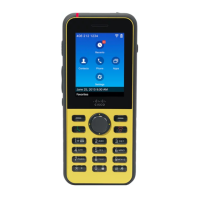Usage notesPurposeNetwork protocol
SDP capabilities, such as codec types, DTMF
detection, and comfort noise, are normally
configured on a global basis by Cisco Unified
Communications Manager or Media Gateway in
operation. Some SIP endpoints may allow
configuration of these parameters on the endpoint
itself.
SDP is the portion of the SIP protocol that
determines which parameters are available during
a connection between two endpoints. Conferences
are established by using only the SDP capabilities
that all endpoints in the conference support.
Session Description
Protocol (SDP)
Like other VoIP protocols, SIP addresses the
functions of signaling and session management
within a packet telephony network. Signaling allows
transportation of call information across network
boundaries. Session management provides the ability
to control the attributes of an end-to-end call.
The phones support the SIP protocol when the
phones are operating in IPv6 address, IPv4 address,
or dual-stack mode.
SIP is the Internet Engineering Task Force (IETF)
standard for multimedia conferencing over IP. SIP
is an ASCII-based application-layer control protocol
(defined in RFC 3261) that can be used to establish,
maintain, and terminate calls between two or more
endpoints.
Session Initiation
Protocol (SIP)
The phones use TCP to connect to Cisco Unified
Communications Manager and to access XML
services.
TCP is a connection-oriented transport protocol.Transmission Control
Protocol (TCP)
Upon security implementation, the phones use the
TLS protocol when securely registering with Cisco
Unified Communications Manager.
TLS is a standard protocol for securing and
authenticating communications.
Transport Layer Security
(TLS)
TFTP requires a TFTP server in your network that
the DHCP server can automatically identify. If you
want a phone to use a TFTP server other than the
one that the DHCP server specifies, you must
manually assign the IP address of the TFTP server
by using the Network Configuration menu on the
phone.
For more information, see the documentation for
your particular Cisco Unified Communications
Manager release.
TFTP allows you to transfer files over the network.
On the Cisco IP Phone, TFTP enables you to obtain
a configuration file specific to the phone type.
Trivial File Transfer
Protocol (TFTP)
UDP is used only for RTP streams. SIP signaling
on the phones do not support UDP.
UDP is a connectionless messaging protocol for
delivery of data packets.
User Datagram Protocol
(UDP)
Related Topics
Manually Set Up the Phone Network from the Settings Menu , on page 65
Cisco Unified Communications Manager Interaction, on page 29
802.11 Standards for WLAN Communications, on page 23
Startup Sequence, on page 7
Cisco Wireless IP Phone 8821 and 8821-EX Administration Guide for Cisco Unified Communications Manager
18
VoIP Networks
Network Protocols

